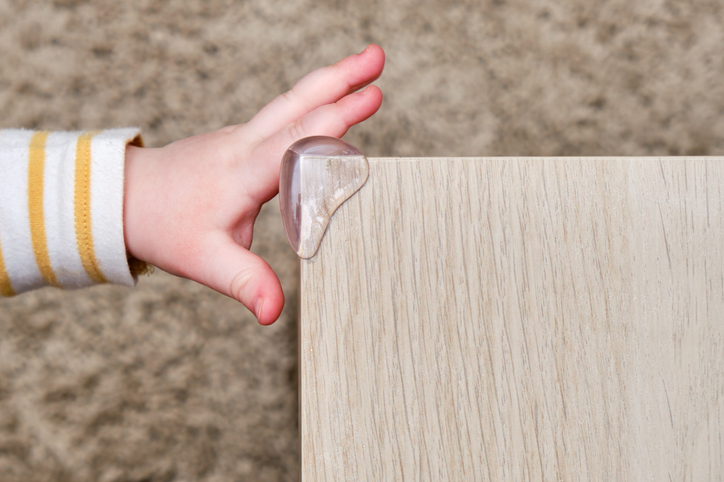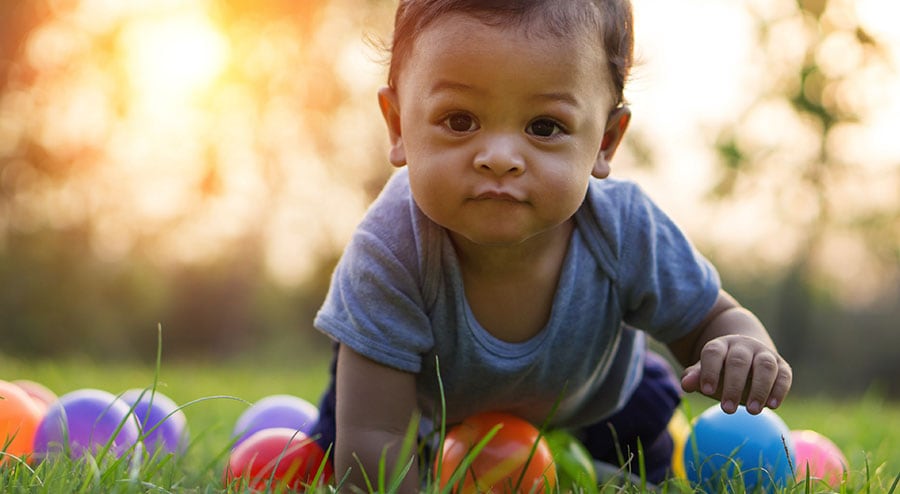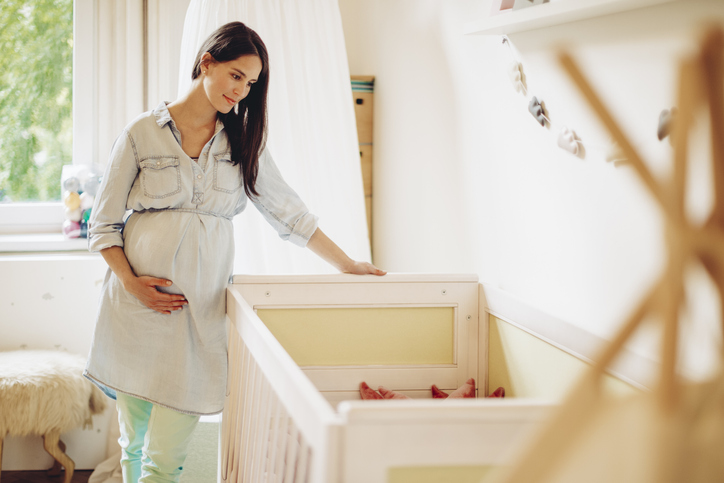Creating a safe environment for your baby is of utmost importance to ensure their well-being and development. As infants are curious explorers, they are prone to accidents and injuries within the home. That’s why it’s crucial for parents and caregivers to take proactive measures to babyproof their living spaces.

Smart baby proofing can significantly reduce the risk of accidents, such as falls, burns, choking incidents, and other potential dangers. Remember, baby proofing is an ongoing process that should evolve as your child grows and develops new abilities. Let us now explore the intricacies of creating a safe environment for your child, ensuring their safety and peace of mind for years to come.
Essential Steps to Babyproofing Your Home
When it comes to creating a safe environment for your infant, there are several crucial measures you should take to address potential hazards and minimize risks. Let’s explore these steps in detail:
Table of Contents
- Essential Steps to Babyproofing Your Home
- Identifying and Addressing Common Household Hazards
- Creating a Safe Sleeping Environment
- Securing Stairs and Gates for Baby Safety
- Kitchen and Bathroom Baby Proofing
- Furniture Safety and Tipping Prevention
- Preventing Electrical Accidents
- Choking Hazards and Toy Safety
- Window and Blind Safety
- Fire Safety and Preventing Burns
- Poisoning Prevention and Chemical Safety
- Take Away
Conduct a Thorough Home Assessment
Start by conducting a room-by-room inspection to identify potential hazards. Look for sharp edges on furniture, exposed electrical outlets, loose cords, and any small objects that could pose choking hazards.
Secure Cabinets and Drawers
Install childproof locks or latches on cabinets and drawers containing cleaning products, medications, sharp utensils, or other potentially harmful items. This prevents your baby from accessing them and reduces the risk of accidental poisoning or injury.
Cover Electrical Outlets
Place childproof outlet covers on all accessible outlets to prevent your baby from inserting their fingers or objects into them. Consider using sliding plate covers for outlets in use to provide continuous protection.
Install Safety Gates
Use safety gates to block off stairways, doorways, and areas that are not baby-friendly. Choose gates that meet safety standards, have secure latches, and can be firmly installed to prevent your baby from accessing hazardous areas.
Anchor Furniture
Heavy furniture, such as dressers, bookshelves, and TVs, should be anchored to the wall to prevent tipping accidents. Use furniture straps or brackets to secure them, especially as your baby starts pulling up and becomes more mobile.
Ensure Window Safety
Install window guards or window stops to prevent falls from open windows. Keep furniture away from windows to discourage climbing and ensure that blind cords are out of reach or secured with cord winders or cleats to eliminate the risk of strangulation.
Eliminate Choking Hazards
Regularly scan the floor for small objects that could pose choking hazards. Keep small items, such as coins, buttons, or batteries, out of your baby’s reach. Be cautious with balloons, as they can present a suffocation risk if they pop or deflate.
Create a Safe Sleeping Environment
Choose a crib that meets safety standards, with a firm mattress that fits snugly. Remove pillows, blankets, and stuffed animals from the crib, as they can pose suffocation hazards. Use a sleep sack or wearable blanket for warmth instead.
Keep Hot Items Out of Reach
Be mindful of hot liquids, such as hot beverages or pots on the stove. Use back burners and turn pot handles inward to prevent accidental spills or burns. Keep electrical appliances, like hair dryers or irons, unplugged and out of reach when not in use.
By following these essential steps and implementing the necessary precautions, you can create a safer environment for your baby to explore, learn, and grow. Remember, supervision is key, and it’s important to adapt and update your baby proofing strategies as your child develops new skills and abilities.
Identifying and Addressing Common Household Hazards
When it comes to creating a safe environment for your infant, it’s crucial to identify and address the common household hazards that exist within your home. Household hazards are potential dangers or risks present in a home environment that can jeopardize the safety and well-being of its occupants. To ensure a safe environment for your baby, it is important to be aware of household hazards including cabinets and drawers, electrical outlets and cords, potential furniture tipping, as well as some other common hazards.
Cabinets and Drawers
Securing cabinets and drawers is a crucial step in creating a safe home environment. These storage spaces often contain potentially harmful substances, sharp objects, or choking hazards. Install childproof locks or latches on cabinets and drawers within your baby’s reach, ensuring they are inaccessible to curious little hands. This simple precaution can prevent accidents and keep hazardous items safely out of your child’s reach.
Electrical Outlets and Cords
Electrical outlets and cords pose a significant risk to your child. Babies are naturally curious and may try to insert their fingers or objects into outlets, leading to electrical shocks. Use childproof outlet covers that fit securely and prevent access to the outlets. Additionally, keep cords of appliances, lamps, and electronics neatly tucked away or secured with cord shorteners to minimize the risk of tripping or pulling hazards.
Furniture Tipping
Furniture tipping accidents are a common concern. Infants may attempt to climb or pull on furniture, causing unstable pieces to tip over and potentially injure them. To prevent this, anchor heavy furniture, such as dressers or bookshelves, securely to the wall using brackets or straps. This anchoring technique adds stability and ensures that the furniture remains upright, even when subjected to the exploration of an adventurous little one.
Other Hazards
Other types of potential hazards to consider include window blinds with cords, which can pose a strangulation risk. Opt for cordless blinds or use cord cleats or cord winders to keep the cords safely out of reach. It’s also important to check for sharp edges or corners on furniture and cover them with corner guards or edge bumpers to minimize the risk of injuries.
Identifying and addressing these common household hazards, such as securing cabinets and drawers, covering outlets, anchoring furniture, and mitigating cord-related risks, allows you to significantly enhance the safety of your home for your baby. Remember, regular inspections and maintenance are essential to ensure that safety measures remain effective as your child continues to explore their environment.
Creating a Safe Sleeping Environment
Ensuring a safe sleeping environment for your baby is essential for their well-being and to minimize the risk of sleep-related accidents. Let’s explore the importance of a safe crib and the guidelines to follow when creating a secure sleep space for your little one.
Selecting the right crib is crucial. Choose a crib that meets the current safety standards, such as having a firm mattress that fits snugly within the crib frame. The spacing between the slats should be no wider than 2 3/8 inches (about the width of a soda can) to prevent your baby from getting stuck or slipping through. Look for cribs certified by organizations such as the Juvenile Products Manufacturers Association (JPMA) or those that meet the safety guidelines set by the Consumer Product Safety Commission (CPSC). Brands like Graco, Delta Children, and Babyletto are well-known for their safety-focused cribs.
Avoid using crib bumpers, pillows, blankets, or stuffed animals in the crib. These items can pose suffocation hazards and increase the risk of sudden infant death syndrome (SIDS). Instead, opt for a sleep sack or wearable blanket to keep your baby warm without the need for loose bedding.
Ensure that the crib is free from any potential hazards. Check for loose or broken parts, sharp edges, or protruding screws or nails. Keep the crib away from windows, cords, and blinds to prevent strangulation or entanglement hazards.
Regularly inspect the crib for any damage or wear and tear. It’s important to maintain a sturdy and secure sleep space for your baby. As your child grows and becomes more mobile, adjust the crib mattress to the lower positions to prevent climbing or falling out.
Following these guidelines and creating a safe sleeping environment provides your baby with a secure and peaceful place to rest and promote healthy sleep habits. Be sure to always place your baby on their back to sleep, in a crib that is clear of hazards, and to monitor the temperature of the room to ensure comfort and safety throughout the night.
Securing Stairs and Gates for Baby Safety
Securing stairs and gates is crucial for your baby’s safety, preventing falls and providing a barrier to restricted areas. Follow these tips to effectively secure stairs and install gates in your home.
Install sturdy handrails on both sides of the stairs, ensuring they are securely fastened and free from any damage or hazards. Regularly inspect the stairs for any loose steps or sharp edges.
To prevent falls, use safety gates at the top and bottom of the staircase. Choose gates that meet safety standards, such as ASTM or JPMA certification. Popular brands like Evenflo, Regalo, and Summer Infant offer reliable options.
Measure the width of your stairway before purchasing a gate to ensure a proper fit. There are two main types of gates: pressure-mounted and hardware-mounted. Pressure-mounted gates use pressure to secure them temporarily, while hardware-mounted gates require installation with screws for a more permanent solution.
Follow the manufacturer’s instructions for proper installation, ensuring the gate is securely fastened. Regularly check the gate for stability and any signs of damage. Choose gates with vertical slats or mesh panels, as horizontal bars can be climbed by children. The cost of safety gates varies depending on brand, type, and features, ranging from $20 to $100. Consider your home’s needs and budget when selecting the most suitable gates for your stairs.
Securing stairs with handrails and installing reliable safety gates provide essential protection, reducing the risk of falls and keeping your baby safe. Prioritize safety measures and remain vigilant to ensure the well-being of your little one.
Kitchen and Bathroom Baby Proofing
Baby proofing the kitchen and bathroom areas is crucial as these spaces often contain potential hazards for your child.
In the kitchen, start by securing appliances and hazardous items. Use appliance locks or latches to prevent your baby from opening ovens, dishwashers, or other appliances that could cause burns or injuries. Store sharp objects, such as knives and utensils, in locked drawers or high cabinets. Consider using cabinet locks or latches to prevent access to cleaning supplies, chemicals, and other potentially harmful substances.
To babyproof the bathroom, one essential measure is water temperature control. Install anti-scald devices on faucets and showerheads to regulate the water temperature and prevent accidental burns. Test the water temperature before placing your baby in the bath to ensure it is comfortably warm but not too hot.
Additionally, prevent access to harmful substances by keeping medications, toiletries, and cleaning products out of reach or locked away in cabinets. Install cabinet locks or latches to secure the bathroom cabinets, especially those containing hazardous items. Avoid leaving standing water in bathtubs or buckets to reduce the risk of drowning.
Several brands offer baby proofing products specific to kitchen and bathroom areas. Safety 1st, Munchkin, and Dreambaby are reputable brands that provide a range of safety locks, latches, and appliance covers. Prices for these products can vary, starting from around $5 for a pack of cabinet locks and going up to $20 or more for appliance locks or faucet covers.
You can significantly minimize the risks associated with the kitchen and bathroom areas by implementing these specific guidelines and utilizing reliable baby proofing products. Ensure to consistently supervise your baby in these spaces and ensure that all safety measures are in place to create a safe environment for exploration while reducing potential hazards.
Furniture Safety and Tipping Prevention
Unsecured furniture poses significant risks to your baby’s safety, especially when it comes to tipping accidents. Tipping accidents occur when a child tries to climb or pull on unsecured furniture, leading to the piece toppling over. This can result in serious injuries, such as head trauma or fractures. Heavy furniture, like dressers, bookcases, or televisions, are particularly prone to tipping hazards.
Anchoring heavy furniture to the wall is crucial to prevent tipping accidents. Use furniture straps, brackets, or wall anchors specifically designed for this purpose. Brands such as Safety 1st, TV and Furniture Safety Straps, and Dreambaby offer reliable furniture anchoring products.
When securing furniture, follow the manufacturer’s instructions carefully and ensure that the anchoring devices are securely attached to both the furniture and the wall. Place the anchor at the top of the furniture and attach it to a stud in the wall for maximum stability. Consider using multiple anchors for larger or taller pieces.
It’s important to regularly inspect and maintain the stability of the furniture anchors. Check for any signs of loosening or damage and tighten or replace them as needed. Educate older children about the importance of not climbing or hanging on furniture to avoid accidents.
Investing in furniture anchoring products can range in cost depending on the brand and the number of straps or anchors included. Typically, a set of furniture straps or wall anchors can cost between $10 and $30, depending on the quantity and quality.
By securing heavy furniture and properly anchoring it to the wall, you can greatly reduce the risk of tipping accidents and provide a safer environment for your baby. Make sure to install anchors in all rooms where heavy furniture is present and remain vigilant to ensure the stability of the secured pieces over time.
Preventing Electrical Accidents
Electrical accidents can pose serious risks to your baby’s safety. One of the main risks is the exposure of electrical outlets. Babies are naturally curious and may try to insert their fingers or objects into the outlets, leading to electrical shocks. To prevent this, it’s essential to use childproof outlet covers or outlet plugs. These safety devices are designed to block access to the outlets and provide a barrier against potential electrical hazards. Brands like Safety 1st, Mommy’s Helper, and LectraLock offer reliable outlet covers and plugs for childproofing.
In addition to outlets, cords can also pose risks. To minimize hazards, keep cords of electrical appliances, such as lamps or chargers, out of your baby’s reach. Use cord shorteners, cord concealers, or cable management systems to secure and organize cords along the walls or furniture. Be cautious of cords from window blinds or curtains as well, as they can present a strangulation hazard. Use cord cleats or winders to keep blind cords out of your baby’s reach.
Inspect electrical cords regularly for any signs of wear, such as fraying or exposed wires. Replace damaged cords promptly to reduce the risk of electrical accidents. Consider using cord covers or cord protectors to shield cords from chewing or tampering by your baby.
Taking advantage of these preventative measures and using childproof outlet covers, cord management solutions, and cord protectors, creates a safer environment for your baby and greatly reduces the risk of electrical accidents. Regularly assess the safety of electrical outlets and cords in your home to ensure they remain secure and free from potential hazards.
Choking Hazards and Toy Safety
When creating a safe environment for your infant, it’s crucial to be aware of common choking hazards and ensure toy safety. Small objects like coins, buttons, batteries, beads, or small toy parts can pose a significant risk if swallowed. Keep these items out of reach and regularly scan play areas for potential hazards.
Select age-appropriate toys with appropriate safety certifications, such as ASTM F963 or CPSC seal. Avoid toys with small, detachable parts and check for any loose or broken pieces. Choose toys made of non-toxic materials without harmful substances like lead.
For infants, opt for soft toys, teething toys, and large, sturdy rattles. As your baby grows, introduce toys that promote exploration and motor skills, such as shape sorters, stacking blocks, and toys with different textures.
Regularly inspect toys for wear and tear, discarding broken or unsafe items. Store toys properly, keeping small parts separate. Stay updated on toy recalls through the CPSC website.
By being vigilant about choking hazards, selecting safe toys, and providing age-appropriate play items, you can minimize the risk of choking incidents and ensure a safe and enjoyable playtime for your little one. Always supervise your baby during play and encourage safe exploration with developmentally appropriate toys.
Window and Blind Safety
Windows and blinds can present potential dangers for infants. One of the primary concerns is preventing falls from windows. Keep furniture, such as cribs or chairs, away from windows to discourage climbing. Install window guards or window stops to limit the window opening size and prevent your baby from accidentally falling out. Window guards should be sturdy, properly installed, and easy to remove in case of emergencies.
Blind cords can also be a danger to look for when assessing your home’s window safety. Cords from window blinds pose a strangulation hazard for infants and young children. Use cordless blinds whenever possible or choose blinds with inaccessible cords. If corded blinds are already in place, use cord cleats or winders to keep the cords securely out of your baby’s reach.
Regularly inspect blinds for any damaged or looped cords and replace or repair them immediately. When purchasing new blinds, consider those with built-in cord safety features like cord tensioners or breakaway cords. Brands such as Bali, Levolor, and Hunter Douglas offer cordless and cord-safe blinds.
Taking these measures to prevent falls from windows and addressing the risks associated with blind cords, can significantly enhance the safety of your home for your baby. Educate caregivers, family members, and babysitters about window and blind safety of the associated risks to minimize accidents and regularly assess and maintain the security of window guards and blinds to ensure they remain effective in safeguarding your child.
Fire Safety and Preventing Burns
Fire safety is of utmost importance when creating a safe environment for your infant. It’s essential to take precautions and implement safety measures to prevent fires and burns in the home. Let’s explore key areas of concern and guidelines for fire safety.
One potential fire hazard is fireplaces. Use a sturdy fireplace screen or gate to prevent your baby from accessing the flames or hot surfaces. Ensure that the fireplace is properly maintained, with regular chimney inspections and cleanings to reduce the risk of chimney fires. Keep flammable items, such as curtains or furniture, at a safe distance from the fireplace.
Heaters, including space heaters, can also pose a fire hazard. Keep heaters at least three feet away from flammable materials and never leave them unattended. Opt for heaters with safety features such as tip-over shut off and overheat protection. Follow manufacturer instructions for proper usage and maintenance.
Preventing burns in the home is crucial. Set the water heater temperature to 120 degrees Fahrenheit or below to prevent scalds from hot water. Always test the temperature of bathwater before placing your baby in the tub. Use a thermometer or your elbow to ensure the water is comfortably warm but not too hot.
Keep hot liquids, such as coffee or tea, out of your baby’s reach and away from the edge of countertops or tables. Use the back burners on stoves whenever possible, and turn pot handles inward to prevent accidental spills or burns. Store electrical appliances, like hairdryers or curling irons, unplugged and out of reach when not in use.
Taking the time to learn key fire safety procedures, such as having a working smoke detector on each floor and developing a family fire escape plan is a smart way to avoid these kinds of hazards. Parents who take these precautions and implement safety measures for fireplaces, heaters, and burn prevention, can significantly reduce the risk of fires and burns in your home. Prioritize fire safety awareness, regularly assess potential fire hazards, and ensure that all family members are knowledgeable about fire prevention and emergency procedures.
Poisoning Prevention and Chemical Safety
Ensuring the safety of your infant involves taking precautions to prevent accidental poisoning and promoting chemical safety in your home. One crucial step in poisoning prevention is safely storing household cleaning products and chemicals. Keep them out of your baby’s reach by storing them in locked cabinets or high shelves. Be mindful of products that may seem harmless but can be toxic if ingested, such as laundry pods or dishwasher detergent packets. Always store them in their original containers with child-resistant caps tightly secured.
When using cleaning products or chemicals, follow the instructions provided by the manufacturer. Be cautious of mixing different products, as this can result in hazardous chemical reactions. Use them in well-ventilated areas and avoid exposing your baby to fumes or residue. After use, immediately return products to their secure storage location.
To promote chemical safety, consider using safer, non-toxic alternatives for cleaning, such as vinegar and baking soda. These natural ingredients can effectively clean without posing the same risks as conventional chemical cleaners. Look for eco-friendly cleaning products that are labeled as non-toxic or environmentally friendly.
In case of accidental poisoning, keep the poison control hotline number and local emergency services easily accessible. Familiarize yourself with the signs and symptoms of poisoning, such as nausea, vomiting, or difficulty breathing. If you suspect your baby has ingested a harmful substance, contact the poison control center or seek immediate medical attention.
Implementing measures including safely storing and handling household cleaning products and chemicals, you can significantly reduce the risk of accidental poisoning and promote chemical safety in your home. Stay informed about potential hazards and consider using safer alternatives to create a healthier environment for your baby.
Take Away
It’s important to recognize that as your baby grows and develops, new risks and hazards may emerge which will require you to adapt your baby proofing strategies accordingly. Creating a safe home environment for your baby requires a combination of awareness, vigilance, and proactive measures. By prioritizing their safety and taking the necessary steps to babyproof your home, you can provide a secure and nurturing environment where your infant can thrive and explore with confidence.




